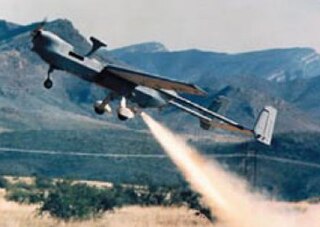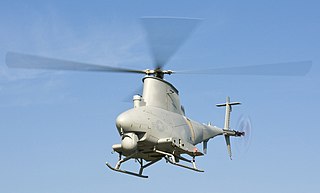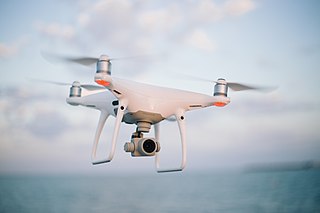
The IAI RQ-5 Hunter unmanned aerial vehicle (UAV) was originally intended to serve as the United States Army's Short Range UAV system for division and corps commanders. It took off and landed on runways. It used a gimbaled EO/IR sensor to relay its video in real time via a second airborne Hunter over a C-band line-of-sight data link. The RQ-5 is based on the Hunter UAV that was developed by Israel Aerospace Industries.

An unmanned aerial vehicle (UAV), commonly known as a drone, is an aircraft without any human pilot, crew, or passengers on board. UAVs are a component of an unmanned aircraft system (UAS), which includes adding a ground-based controller and a system of communications with the UAV. The flight of UAVs may operate under remote control by a human operator, as remotely-piloted aircraft (RPA), or with various degrees of autonomy, such as autopilot assistance, up to fully autonomous aircraft that have no provision for human intervention.

The Bell Helicopter Eagle Eye, Model 918, was an American tiltrotor unmanned aerial vehicle that was offered as one of the competitors in the United States Navy's VT-UAV program.

Aerial application, or what is informally referred to as crop dusting, involves spraying crops with crop protection products from an agricultural aircraft. Planting certain types of seed are also included in aerial application. The specific spreading of fertilizer is also known as aerial topdressing in some countries. Many countries have severely limited aerial application of pesticides and other products because of environmental and public health hazards like spray drift; most notably, the European Union banned it outright with a few highly restricted exceptions in 2009, effectively ending the practice in all member states.

The Northrop Grumman MQ-8 Fire Scout is an unmanned autonomous helicopter developed by Northrop Grumman for use by the United States Armed Forces. The Fire Scout is designed to provide reconnaissance, situational awareness, aerial fire support and precision targeting support for ground, air and sea forces. The initial RQ-8A version was based on the Schweizer 330, while the enhanced MQ-8B was derived from the Schweizer 333. The larger MQ-8C Fire Scout variant is based on the Bell 407.

The Boeing A160 Hummingbird is an unmanned aerial vehicle (UAV) helicopter. Its design incorporates many new technologies never before used in helicopters, allowing for greater endurance and altitude than any helicopter currently in operation.

A quadcopter or quadrotor is a type of helicopter with four rotors.

The Northrop Grumman X-47B is a demonstration unmanned combat aerial vehicle (UCAV) designed for aircraft carrier-based operations. Developed by the American defense technology company Northrop Grumman, the X-47 project began as part of DARPA's J-UCAS program, and subsequently became part of the United States Navy's Unmanned Combat Air System Demonstration (UCAS-D) program. The X-47B is a tailless jet-powered blended-wing-body aircraft capable of semi-autonomous operation and aerial refueling.

The Schweizer 330 and S333 are turbine-powered developments of the Schweizer 300 light piston-powered helicopter. As of 2007, only the Schweizer 333 remains in production. In February 2009, the 333 was rebranded as the Sikorsky S-333. In 2018 the Schweizer R.S.G. bought the Schweizer Aircraft from Sikorsky Aircraft and it was rebranded as Schweizer S333 again.

The Kaman K-MAX is an American helicopter with intermeshing rotors (synchropter) by Kaman Aircraft. It is optimized for external cargo load operations, and is able to lift a payload of over 6,000 pounds (2,700 kg), which is more than the helicopter's empty weight. An unmanned aerial vehicle version with optional remote control has been developed and evaluated in extended practical service in the war in Afghanistan.

The Northrop Grumman Bat is a medium-altitude unmanned air vehicle originally developed for use by the United States Armed Forces. Designed primarily as an intelligence "ISR" gathering tool, the Bat features 30 lb (14 kg) payload capacity that is unmatched in a 10 ft (3.0 m) wing span.

The Boeing AH-6 is a series of light helicopter gunships based on the MH-6 Little Bird and MD 500 family. Developed by Boeing Rotorcraft Systems, these include the Unmanned Little Bird (ULB) demonstrator, the A/MH-6X Mission Enhanced Little Bird (MELB), and the proposed AH-6I and AH-6S.

Aeryon Scout is a small reconnaissance unmanned aerial vehicle (UAV) that was designed and built by Aeryon Labs of Waterloo, Ontario, Canada. The vehicle was developed between 2007 and 2009 and produced from 2009-2015. Production has been completed and it is no longer advertised for sale on the company website.

KQ-X was a $33 million DARPA program awarded to Northrop Grumman on July 1, 2010. KQ-X investigated and developed autonomous aerial refueling techniques using two NASA Global Hawk high-altitude long endurance (HALE) unmanned aerial vehicles (UAVs).
BUAA unmanned helicopters are Chinese UAVs developed by Beihang University (BUAA), some of which have entered service with the Chinese military and government establishments.
NRIST Unmanned Helicopters are Chinese UAVs developed by Nanjing Research Institute of Simulation Technology (南京模拟技术研究所) (NRIST), also known as the 60th Research Institute of People's Liberation Army General Staff Department (总参六十所), an ISO 9001 certified research/production facility headquartered in Nanjing.

The Northrop Grumman MQ-8C Fire Scout is an unmanned helicopter developed by Northrop Grumman for use by the United States Navy. The MQ-8C also has autonomous take-off and landing capability. It is designed to provide reconnaissance, situational awareness, aerial fire support and precision targeting support for ground, air and sea forces. The MQ-8C airframe is based on the Bell 407, while the avionics and other systems are developed from those used on the MQ-8B Fire Scout. It first flew in October 2013 and achieved initial operational capability on 28 June 2019.

The Tactical Robotics Cormorant, formerly AirMule or Mule, Israel Defense Forces (IDF) codename Pereira, is a flying car unmanned aerial vehicle (UAV) built by Tactical Robotics Ltd., a subsidiary of designer Rafi Yoeli's Urban Aeronautics Ltd., in Yavne, Israel. It will be used in search and rescue operations where it is too dangerous or inaccessible for a helicopter, such as evacuating people from the upper stories of burning buildings, or delivering and extracting police and soldiers while very close to structures, narrow streets, or through holes into confined spaces.
















